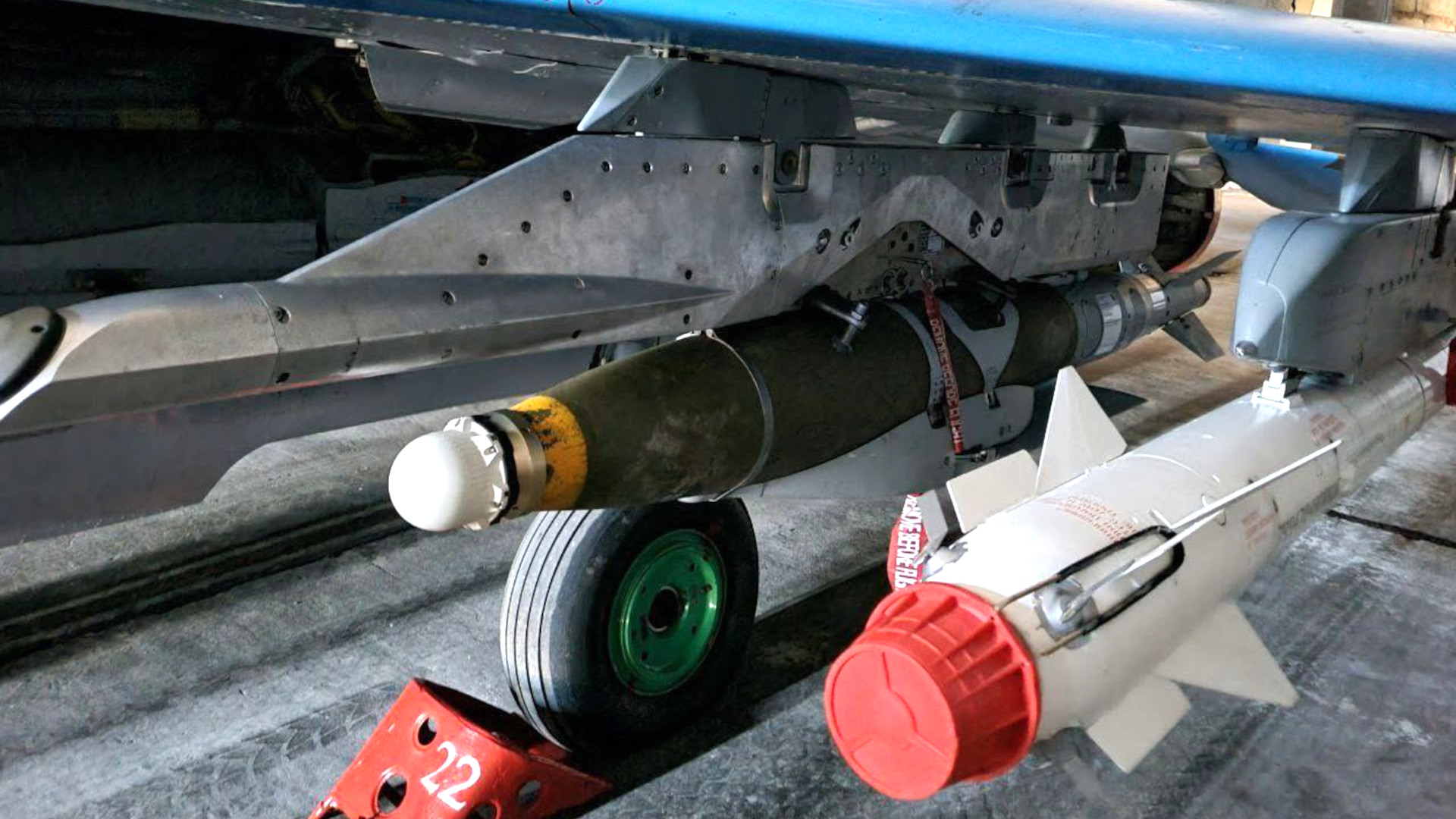A picture, seen a the top of this story and uncropped below, has emerged offering the best look to date at a unique pylon that Ukrainian MiG-29 Fulcrum fighters, as well as Su-27 Flankers, are using to carry U.S.-supplied JDAM-ER precision-guided glide bombs. A photograph of a MiG-29 fitted with a pair of these visually distinctive pylons, which have tapered protrusions that extend well forward of where the bomb is attached, first appeared back in June.
The JDAM-ER-armed MiG-29 seen in the new picture showing off the pylon design has the bort number White 22. The jet, which is also seen with an R-73 short-range heat-seeking air-to-air missile under its left wing, is sitting inside a hangar at an unknown location. Ukrainian combat jets are known to regularly move from one base to another to make it more difficult for Russian forces to target them.

Though the pylon onto which the JDAM-ER is still not fully visible, it is now clear that the protrusion in front has some kind of black-colored antenna/sensor, emitter, or at least an aperture to accommodate one of them, at the front. The exact purpose of this fixture is unknown.

The War Zone previously explored a number of possibilities behind the pylon’s unique design. These included the potential that the protrusion could be part of an electronic support measures (ESM) or radar homing and warning receiver (RHWR) suite, or might be an element of an electronic warfare jamming system. These capabilities would all be valuable self-protection tools for Ukrainian pilots who face serious Russian air defense threats on a regular basis.

The War Zone previously laid out how an ESM/RHWR capability could also be particularly useful when combined with U.S.-made AGM-88 High-speed Anti-Radiation Missiles (HARM). Ukrainian MiG-29 and Su-27s have been employing HARMs, which are primarily designed to zero in on hostile air defense radars, during defense-suppression missions since last year.

However, this pylon with the protrusion has only ever been seen in connection with the JDAM-ER. HARMs have been seen loaded on MiG-29s and Su-27s using other pylon configurations without any similar features.


If the pylon’s design is not related to the AGM-88, this raises questions about whether it may be tied in some way to the cueing of the JDAM-ER to its target – and this could well be the case. The JDAM-ER uses a GPS-assisted inertial navigation system (INS) guidance package to strike a fixed set of coordinates. Those coordinates can be preloaded onto the bomb on the ground or the pilot can program it in flight so long as the appropriate data linkages and user interfaces are present. How those coordinates are derived can vary.
What doesn’t change is the bomb’s need for locational data at the moment of launch to understand its relative position to the target. However, Ukraine’s MiG-29s and Su-27s do not have the kind of integrated GPS/INS capability and a NATO-compatible data bus that is needed for JDAM-ER. So, the fixture at the end of the pylon could be a GPS antenna that feeds key information into the bombs before they are released. Mounting it on the protrusion would help ensure it has a clear line of sight to the satellite constellation and is not shadowed by the aircraft’s wing structure.
All of this would provide a useful and self-contained workaround to help ensure that Ukrainian pilots can employ the JDAM-ER without severely degrading its capabilities and requiring any more complex integration work than is necessary. There is also the possibility that this unique arrangement may be a contributing factor in reports that Russian electronic warfare systems have been able to degrade the effectiveness of Ukrainian JDAM-ERs.
As The War Zone has explained in detail before, JDAM-ER provides Ukrainian forces with a major boost in capability given its ability to precisely hit targets up to 45 miles away. This helps to keep pilots further away from hostile air defenses. You can read more about JDAM-ER’s capabilities and what it offers Ukraine’s Air Force specifically here.

There is also a possibility that the unique pylon design now in Ukrainian service has nothing to do with the targeting of any specific weapon, though this seems increasingly unlikely. Various degrees of work have clearly been required to integrate a number of different Western air-launched munitions and stores onto Ukraine’s combat jets. Using that as an opportunity to add on additional capabilities, such as electronic warfare jammers for self-protection, would also make good sense. Pylons with various kinds of integrated defensive capabilities are already in service with air forces around the world.
Whatever the exact purpose of special pylons that Ukrainain MiG-29s and Su-27s have been using to carry JDAM-ERs might be, we do at least now know for certain that the design incorporates some kind of antenna/sensor or emitter at the front.
Contact the author: joe@thedrive.com
